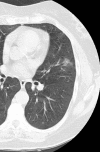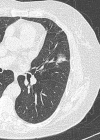CT Screening for Lung Cancer: Nonsolid Nodules in Baseline and Annual Repeat Rounds
- PMID: 26101879
- PMCID: PMC4627436
- DOI: 10.1148/radiol.2015142554
CT Screening for Lung Cancer: Nonsolid Nodules in Baseline and Annual Repeat Rounds
Abstract
Purpose: To address the frequency of identifying nonsolid nodules, diagnosing lung cancer manifesting as such nodules, and the long-term outcome after treatment in a prospective cohort, the International Early Lung Cancer Action Program.
Materials and methods: A total of 57,496 participants underwent baseline and subsequent annual repeat computed tomographic (CT) screenings according to an institutional review board, HIPAA-compliant protocol. Informed consent was obtained. The frequency of participants with nonsolid nodules, the course of the nodule at follow-up, and the resulting diagnoses of lung cancer, treatment, and outcome are given separately for baseline and annual repeat rounds of screening. The χ(2) statistic was used to compare percentages.
Results: A nonsolid nodule was identified in 2392 (4.2%) of 57,496 baseline screenings, and pathologic pursuit led to the diagnosis of 73 cases of adenocarcinoma. A new nonsolid nodule was identified in 485 (0.7%) of 64,677 annual repeat screenings, and 11 had a diagnosis of stage I adenocarcinoma; none were in nodules 15 mm or larger in diameter. Nonsolid nodules resolved or decreased more frequently in annual repeat than in baseline rounds (322 [66%] of 485 vs 628 [26%] of 2392, P < .0001). Treatment of the cases of lung cancer was with lobectomy in 55, bilobectomy in two, sublobar resection in 26, and radiation therapy in one. Median time to treatment was 19 months (interquartile range [IQR], 6-41 months). A solid component had developed in 22 cases prior to treatment (median transition time from nonsolid to part-solid, 25 months). The lung cancer-survival rate was 100% with median follow-up since diagnosis of 78 months (IQR, 45-122 months).
Conclusion: Nonsolid nodules of any size can be safely followed with CT at 12-month intervals to assess transition to part-solid. Surgery was 100% curative in all cases, regardless of the time to treatment.
© RSNA, 2015
Figures




Comment in
-
Management of CT Screening-detected Persistent Nonsolid Pulmonary Nodules: An Asian Perspective.Radiology. 2016 Jul;280(1):324-6. doi: 10.1148/radiol.2016152476. Radiology. 2016. PMID: 27322980 No abstract available.
-
How to Define and Display Solid Components within Ground-Glass Nodules and Differentiate Pure Ground-Glass Nodules from Mixed Ground-Glass Nodules?Radiology. 2016 Oct;281(1):325-6. doi: 10.1148/radiol.2016160541. Radiology. 2016. PMID: 27643776 No abstract available.
References
-
- Kitamura H, Kameda Y, Nakamura N, et al. . Atypical adenomatous hyperplasia and bronchoalveolar lung carcinoma: analysis by morphometry and the expressions of p53 and carcinoembryonic antigen. Am J Surg Pathol 1996;20(5):553–562. - PubMed
-
- Wang JC, Sone S, Feng L, et al. . Rapidly growing small peripheral lung cancers detected by screening CT: correlation between radiological appearance and pathological features. Br J Radiol 2000;73(873):930–937. - PubMed
-
- Henschke CI, Yankelevitz DF, Mirtcheva R, et al. . CT screening for lung cancer: frequency and significance of part-solid and nonsolid nodules. AJR Am J Roentgenol 2002;178(5):1053–1057. - PubMed
-
- Henschke CI, Shaham D, Yankelevitz DF, et al. . CT screening for lung cancer: significance of diagnoses in its baseline cycle. Clin Imaging 2006;30(1):11–15. - PubMed
Publication types
MeSH terms
Grants and funding
LinkOut - more resources
Full Text Sources
Other Literature Sources
Medical

